An Evaluation of the Commonwealth Games 2014 Legacy for Scotland Report 1: Questions, Methods and Baseline
This report sets out the broad approach to the Glasgow 2014 legacy evaluation,the research questions it will address, and the range of methods that will be deployed between now and 2019. It also sets out the priorities for the next 18 months and a forward timetable for publication of reports.The report also has a series of Annexes on the 4 national themes (flourishing, active, connected and sustainable).
Annex 4: Sustainable
Introduction
The Glasgow 2014 Games provides a potential catalyst to help communities live more sustainably, and creates an opportunity to demonstrate environmental responsibility. This is reflected in the high environmental standards set out as part of Glasgow's successful bid for delivering the Games, and in the plans for creating an enduring legacy extending across Glasgow, Scotland and for some of the Commonwealth counties before and beyond the 2014 Games.
'Sustainable' can be seen as one of the most multi-faceted legacy themes of the Glasgow 2014 Games and has environmental, regeneration, social, community and some international elements to it. These elements are being delivered at different levels and by a number of different agencies, including local and national government and international charitable organisations. They are working together as part of unique partnership to deliver a Sustainable legacy for Scotland.
Previous Research
In considering how to deliver a 'Sustainable' legacy important lessons can be learned from research evidence on delivering large scale sporting events. The overarching messages from the research review are:
- Hosting a large event can create a large environmental footprint in terms of the waste created, travel required and food and drink consumed.
- Due consideration must be given to how sporting infrastructure is used in the long-term.
- Games-related regeneration should be incorporated into long-term regeneration objectives.
- Regeneration initiatives associated with major sporting events can have both positive and negative impact. One issue raised in the literature was forced evictions and forced relocation of local housing and business.
In detail the research also pointed to a range of issues that can be related to the regeneration process:
- A tendency to replace what has been before rather than building on existing resources.
- A lack of clear communication channels between local officials and residents.
- A lack of acknowledgement of the different relative positions of stakeholders, leading to sense of powerlessness among residents.
Finally a substantial body of research also highlighted the potential problem of long‐term use of event infrastructure, often referred to as the problem of 'White Elephants', and highlighted a number of strategic issues:
- Insufficient long‐term plans for legacy, instead it was assumed that legacy would happen naturally.
- Lack of coordination between the public and the private sector.
- Too much focus on the inner city with insufficient integration with wider areas.
- Permanent buildings that were too large for everyday use.
In the development of the delivery of a sustainable legacy a number of the above lessons have been considered including, how venues will be utilised before and after the event; expediting existing regenerations plans within the East End of Glasgow; and the adoption of green Games management techniques for the delivery of the Glasgow 2014 Games.
Strategies and Programmes
An overview of the strategies and programmes that seek to deliver a Sustainable legacy are outlined below under the three intermediate outcomes:
- Improve the physical and social environment of Glasgow, in particular the east end.
- Strengthen and empower communities in Scotland and the Commonwealth.
- Demonstrate sustainable design and environmental responsibility
This is intended to be a current snapshot of some of the activity being undertaken and should not been seen as representative of the whole range of activity.
1) Improve the physical and social environment of Glasgow and in particular the East End.
As part of the regeneration element, which relates to Glasgow and particularly the east end, there has been significant investment in sport venues. These have been built or redeveloped with clear consideration of how Games venues will be utilised before and after the Glasgow 2014 Games.
For example:
- Commonwealth Arena - unparalleled in Scotland, this is one of the largest facilities of its kind in Europe. It is a flexible community facility with 12 Badminton Courts and a Sports Hall complex that comprises three sports halls with 5,000 spectator seats, dance and fitness studios. There are also external multi-court areas, media, event control and hospitality suites and offices for governing bodies of sport and SportsScotland. The flexibility of the arena is showcased through the ability to switch a button which allows a 200-metre indoor athletics track to be hydraulically lifted from below in order to host Indoor Athletics events.
- The Hydro - forming part of the Scottish Exhibition and Conference Centre Precinct the Hydro has been designed by internationally renowned architect Sir Norman Foster. His design includes an amphitheatre-style arena which can house a full Olympic size gymnastics layout with 12,500 seats. The venue has already helped Glasgow to attract the 2015 International Gymnastic Championships
- Tollcross Aquatic Centre - providing the competition venue for swimming in Glasgow 2014 the centre has been upgraded to provide both a warm-up and a competition pool. Other facilities within the aquatic centre have also been up-graded including the changing facilities, fitness suite, health suite and dance studio. The development of Tollcross will provide both Glasgow and Scotland with a world class swimming venue, but importantly will enhance quality and scale of the sporting provision in the East End of Glasgow.
While the majority of sporting venues are within Glasgow City there are also a number of 'satellite' venues located outside Glasgow, for example Barry Buddon near Carnoustie in Angus on the East Coast of Scotland which will host the shooting competition and the Royal Commonwealth Pool in Edinburgh which will host the diving competition. Both of these facilities have been refurbished and provide opportunities for the local community in other areas of Scotland to access the Games.
Building has not been restricted to sports venues, following on from existing regeneration plans; the East End of Glasgow is undergoing an expedited regeneration programme. This accelerated regeneration has been led by the Clyde Gateway Urban Regeneration Company ('Clyde Gateway'). The work of Clyde Gateway is not only about the physical transformation brought about by the vast range of infrastructure being developed and upgraded for and around the Games. It is about involving local people and businesses in decisions and actions that impact on them and their community; giving them their say in influencing and shaping their area.
There have been 76 public consultations over the past three years on various plans and proposals reaching over 1400 people. A steering group of residents has been established to advise and guide Clyde Gateway with on-going plans for the Bridgeton Cross area and it was the views of this group that led Clyde Gateway to purchase the Olympia Theatre and to work up a viable plan to bring it back into use in advance of the 2014 Commonwealth Games.
Over a 20 year period the Clyde Gateway development will eventually include approximately 10,000 homes with around 20,000 new residents by 2028 and this includes the redevelopment of the athletes village which will create around 700 new homes - with approximately 300 homes for social rent and an 120 bed care home.
In addition there will be new and upgraded roads, public transport, parks and walkways which will provide a lasting public infrastructure to support development of the areas economy. For example:
- Dalmarnock Station - will be the main public transport hub for all the sporting venues in the East End of Glasgow. The station is currently undergoing an £11M upgrade that includes the delivery of a new station building, lift access to both platforms, a new pedestrian footbridge and new customer information and communications systems. The redevelopment will provide a lasting physical legacy for the local community following 2014.
- M74 upgrade - the upgrading of the M74 was completed in 2011, it is hoped that it will improve journey times for Games Family members and spectators, with reduced traffic congestion on roads across Glasgow and South Lanarkshire. Those travelling from the Games village to venues out with the city should also benefit.
2) Strengthen and empower communities in Scotland and the Commonwealth
This theme looks at communities, at home and in the Commonwealth, and how they can be empowered and strengthened. The Glasgow 2014 Games also provide a unique opportunity for Scotland to share skills and knowledge within our communities and with other Commonwealth countries.
A programme of projects has been developed and includes:
The Scottish Community Development Centre is now working with ten groups and organisations across the country to help them get involved with legacy activity as part of their Commonwealth Games Legacy for Communities Programme.
Games for Scotland programme, which is in its third year, will see Games for Scotland events take place across 26 local authorities giving local people the chance to join the excitement in the lead up to the 2014 Games and to take part in and enjoy sport and dance activities.
- The Scottish Sport Relief Home and Away Programme was launched in July 2012 and represents a joint partnership between the Scottish Government, Sport Relief and sportscotland. The programme will support a number of projects both at 'home' within Scotland and 'away' in Commonwealth countries. Nine 'home' projects are already being supported and include helping people with mental health problems and learning disabilities. An announcement of those projects supported by the away element of the fund is due by the end of the year.
3) Demonstrate sustainable design and environmental responsibility
Environmental delivery
As highlighted above delivering a large sporting event can potentially have a massive environmental impact and in order to minimise this impact Glasgow 2014 have employed green management methods, for example:
- Adoption of Low Emission Zones - these will be declared around all areas around venues and the athletes village.
- Low waste to landfill - contracting with suppliers to ensure that at least 80% of waste during the Games is diverted from landfill.
- Integrated ticketing systems - encouraging use of public transport to travel to Games venues and creating a legacy of better public transport links more generally across the city.
- BS20121 standard - utilising the British Standard for sustainable event management, used in the London 2012 Olympics, which sets out requirements of planning and managing a sustainable event.
It is hoped that the strategies they have used will deliver a 'green' games and that these, combined with 19 'Green' projects being supported as part of Glasgow City Council's Glasgow 2014 Legacy Framework, will help to make Glasgow one of the most sustainable cities in Europe. The 19 'Green' projects include:
- 2014 Multifunctional Green Space Project - implementing four multifunctional greenspace projects at either vacant and derelict land or low value 'green desert' type amenity sites throughout the City. These focus on ecological enhancements that can deliver a range of additional benefits and functions including water management issues. Two projects have already been confirmed in South Dalmarnock and Camlachie.
- Commonwealth Parks - A wide ranging initiative that includes: identifying Biodiversity Action Projects with a school in each Community Health and Care Partnership area of the city; an eco schools biodiversity day to include a Commonwealth twinning theme each year; habitat creation and enhancement; provide sites within the parks which are suitable for environmental education initiatives and activities delivered by Countryside Rangers. This should contribute to improving the active infrastructure and ensure access to new green spaces across local area.
- 2014 Clyde Walkway Pilot Project (CWPP) - developing and implementing a city-wide Action Plan for the Clyde Walkway, the National Cycle Route 75. As well as setting up a Clyde Walkway Steering Group to implement Clyde Walkway Pilot Project recommendations and to ensure it is kept updated.
- Stalled spaces - supporting community and other groups in the development of stalled space projects (stalled spaces are those ear marked for development but have stalled due to the economic downturn) throughout the City and delvering funded stalled space projects on the ground. In 2011 the project brought almost 12 hectares of stalled space into temporary use.
The strategies link directly with the objective of Glasgow's Environmental Strategy 2006-2010. It is hoped that the Glasgow 2014 Games will be a catalyst for improved environmental outcomes for the city and exemplar for Scotland as a whole. The indicators that we have chosen to measure take account of these ambitions at a Glasgow City level and consider how these ambitions may be translated to Scotland as part of the potential 'demonstration effect' of the Glasgow 2014 Games.
Environmental design
The environmental impact of large events goes beyond delivery of the event itself. In order to create a sustainable legacy, the highest principles of environmental responsibility in design, services and materials are being utilised. New or improved technological methods and materials are being used in the development of the Glasgow 2014 Games Village and venues to provide practical exemplars for future developments. These include:
- The use of a distributed district heating network - establishing the city's first district heating network in Dalmarnock which will use low carbon fuels (biogas) to contribute to low carbon targets associated with the Athletes' Village. The heating system will be operational from December 2013 and is currently being commissioned.
- Sustainable design of athletes village - landscape consultants have advised on how best to increase biodiversity through the introduction of native specifies. Early consideration has been given to the transformation of the athletes village to provide an innovative mix of housing tenure along with a care home of the elderly.
- Sustainable Urban Drainage Systems (SUDS) - SUDS are being used at many of the Commonwealth Games venues including Commonwealth Arena/ Velodrome. GCC, in partnership with the Scottish Environment Protection Agency (SEPA) and Scottish Water, are planning a modern drainage infrastructure network for Glasgow's East End. Their approach aims to take surface water run-off from rainfall out of the normal combined drainage system, freeing up capacity for new development in the area.
It is hoped that these will help to improve sustainable standards of living in the long term within Glasgow.
Environmental community
The Games have also provided the opportunity for existing environmental projects to be expanded. For example:
- The Forestry Commission Scotland have developed nine Community Woodland sites, with additional sites proposed, each has its own activities programme to allow local communities to engage in various activities, including Commonwealth-themed sculpture trails, tree stories and music workshops, walking routes and woodland workouts.
- A new urban woodland is being created at the Cunigar Loop located at the heart of Glasgow's East End.
- The Park Run scheme is being expanded to more communities across Scotland.
- Zero Waste Scotland is now beginning to work with the first 11 facilities, who have agreed to upgrade and use Recycling on the Go to encourage people to recycle more, before 2014. This waste reduction initiative linked to the Glasgow 2014 Games is to encourage increased recycling 'on the go' with a particular focus on sports venues, facilities and major sporting events Scotland wide.
The hope is that through all of programmes outlined above that the Glasgow 2014 Games will help people at home and within the Commonwealth to live more sustainable lives.
Our Sustainable Indicators
Following widespread consultation the following 15 'outcome indicators' were chosen for the 'sustainable' theme. The 'environmental' and 'regeneration' elements of 'sustainable' will impact most within Glasgow and as such the outcome indicators that we have chosen reflect this. However, as has been shown in previous major sporting events there is the potential for a 'demonstration effect' from the event itself and therefore where relevant we also look at some indicators at a Scottish level. It is cleared noted within the text whether we are using Scottish data for context or to show some kind of 'demonstration effect'.
There is still some development, particularly around the 'strengthening and empowering communities' element, of the 'sustainable' theme to be undertaken and we will be working with partners over the coming months on this. However, due to the nature of the projects being undertaken both nationally and internationally it is likely that any evaluative work will be qualitative in nature. This work, along with monitoring data, will be referenced in future reports.
Finally, it is important to note that there is no hierarchy of indicators employed, however indicators have been organised using the intermediate outcomes for 'sustainable'.
Headline Indicators: Sustainable
| HEADLINE INDICATORS | Scotland | Glasgow | East End | Source |
|---|---|---|---|---|
| INTERMEDIATE OUTCOME: Improve the physical and social environment of Glasgow, in particular the east end. | ||||
| S1: Perception of neighbourhood improvement: % of adults who think their neighbourhood has improved in the last 3 years. | √ | GW | SHS | |
| S2: Perception of local community: % of adults who rate their community as a very good place to live | √ | GW | SHS | |
| S3: Perception of community facilities: % of adults satisfied with community centres and facilities | √ | X | SHS | |
| S4: Perception of community safety: % of adults who feel safe in their local area after dark | √ | GW | SCJS | |
| S5: Perception of crime rate: % of adults who perceive the crime rate in there area to have stayed the same ore reduced in the past two years. | √ | GW | SCJS | |
| S6: International Rating of Personal Safety: Mercer Personal Safety Ranking | X | √ | X | Mercer |
| S7: Green Space: Green space in Glasgow and East End (ha) | X | √ | √ | GSS |
| S8: Vacant and Derelict Land - Land brought back into use (ha) and Derelict Land/Vacant and Derelict Land (ha) | X | √ | √ | SVDL |
| S9: Population: Population in Glasgow and East End | X | √ | √ | SGNS |
| S10: Quality of Living: Mercer Quality of Living Ranking | X | √ | X | Mercer |
| INTERMEDIATE OUTCOME: Strengthen and empower communities in Scotland and the Commonwealth. | ||||
| S11: Perception of community influence: % of adults who feel they can influence decisions in their local area | √ | √ | GW | SHS |
| INTERMEDIATE OUTCOME: Demonstrate sustainable design and environmental responsibility. | ||||
| S12: Neighbourhood cleanliness: Over all Cleanliness | X | X | LEAMS | |
| S13: Rates of recycling: % of households recycling items | √ | GW | SHS | |
| S14: Waste destination: % recycled, landfilled and composted | √ | X | SEPA | |
| S15: Understanding of environmental responsibility | √ | X | √ | MORI |
SHS - Scottish Household Survey SGNS - Scottish Government Neighbourhood Statistics; GSS - Greenspace Scotland;
SCJS - Scottish Crime and Justice Survey; LEAMS - Local Environmental Audit and Management System;
SHCS - Scottish House Conditions Survey; SVDL - Scottish Vacant and Derelict Land survey;
SEPA - Scottish Environmental Protection Agency; MORI: Schools Omnibus; Mercer - Mercer quality of living and personal safety ranking
GW will become available through Go Well √ Available X Not relevant/not applicable ![]() For context; not direct influence
For context; not direct influence
Tracking Indicators Since Baseline
In this section we look at the latest available data for all the 'sustainable' indicators, explore why they are important and examine recent trends since 2008. We also look briefly at what we know about the outcomes for sub-groups, where appropriate and available. We will gain more insight on trends and patterns as further data points become available.
It is important to note at this stage, as set out in chapter 2, that the indicators presented here are, in theory, amenable to change due to the Games, but they only form part of the picture, and we would not expect a change in many of these indicators at this juncture. As our work progresses, primary research and evaluation will provide the 'bottom-up' evidence that will help assess the contribution of the Games. More of these data will be available in our 2014 report.
1) Improve the physical and social environment of Glasgow, in particular the east-end.
Ten indicators have been chosen to measure this intermediate outcome; these indicators allow us to measure key aspects of the physical and social environment of Scotland, Glasgow and, where available, the east end. As is noted above, the analysis focuses on Glasgow and the east end as this is where we will see the majority of the initial legacy impact however at a Scottish level there is also the potential for a demonstration effect; therefore data is provided at Scottish level for context and this is clearly noted.
S1: Neighbourhood Improvement
Why is this indicator important? S1 allows us to understand adults' perceptions of whether their neighbourhood has improved over the last three years and is measured within the Scottish Household Survey. This indicator fits within the regeneration element of sustainable and allows us to examine the impact of regeneration on perceptions of neighbourhood improvement in Glasgow, while providing a context for this at a Scottish level. The regeneration being undertaken at Glasgow and East End level is already well underway and it is likely that we would see an increase in perceptions of improvement as these reach completion. However, it is important to consider that there may be some disruption caused by building works, although steps having been taken to minimise this, it could still impact adversely on perceptions of improvements.
Perception of neighbourhood improvement
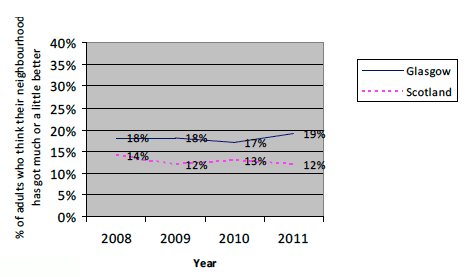
Source: SHS
What do the data tell us? Perceptions of neighbourhood improvement have remained consistent with 17-19% of adults indicating that their area got much better or a little better in the over the last three years between 2008 and 2011. Perceptions of improvement have also remained consistent in Scotland, although at a lower level, over the same time period. In 2011 we see a slight increase at Glasgow level in perceptions of improvement compared to a slight decrease at Scottish levels. In 2013 we will have data from Go Well study for the East End of Glasgow on neighbourhood perception.
S2: Perception of local community
Why is this indicator important? S2 helps us to understand the impact of regeneration on neighbourhood perception within Glasgow. Perceptions of a community being a good place to live are also important in defining a sustainable community (Rogerson et al, 201161 ) and therefore this will provide us with a good measure. The Scottish Household Survey asks whether adults perceive their community to be a very good place to live and we are able to disaggregate this to Glasgow level. Sitting within the improving the physical and social environment of Glasgow section of 'sustainable' this indicator complements S1. It allows us to consider community life as well as improvements as a result of Glasgow 2014 Games related regeneration. The expectation is that the majority of this impact will be in Glasgow and the East End of Glasgow; with an increase in those perceiving their community as a good place to live over time due to the improvements being made city wide.
What do the data tell us?
In Glasgow from 2008 to 2010 there was an increase in the percentage of people who rated their community as a very good place to live from 35.5% in 2008 to 43.9% in 2010, however in 2011 there was a decrease to 38.6%. The decrease was significant, however it should also be noted that the 2010 figure represents the highest recorded since the time series began in 1999. At a Scottish level, we see a higher percentage of adults rating their community as a very good place live, however this has increased less rapidly than at a Glasgow level and remains consistent in 2011. We will be able examine this indicator at an East End level through the GoWell survey in 2013, which asks 'how satisfied or dissatisfied are you with this neighbourhood as a place to live?'.
Perception of community
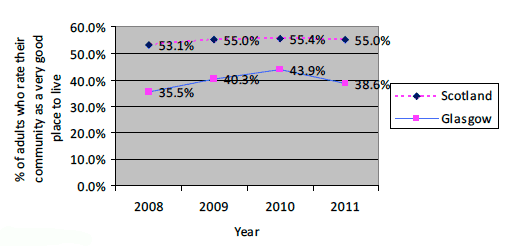
Source: SHS
S3: Perception of community facilities
Why is the indicator important? S3 measures adults' satisfaction with community centres and facilities. The data for this indicator comes from the Scottish Household Survey where adults are asked to rate their satisfaction with the quality of community centres and facilities. Falling within the improving the physical and social environment of 'sustainable' this indicator allows us to look at the impact of the regeneration of facilities within Glasgow for the 2014 Games. Scottish data is also provided here for context, however as suggested within the intermediate outcome we would expect much of the improvement to be within Glasgow, and particularly the east end of Glasgow. It is anticipated that following the development and opening to the public of the Glasgow 2014 Games venues, e.g. sports centres, we would see an increase in adults satisfaction. In a similar way to S1, however, there may be an adverse impact due to the building work being undertaken and some centres being closed while they are being refurbished. We might expect this adverse impact to be mitigated once data is available from the period when the venues are open.
What do the data tell us? In Glasgow, the proportion of adults stating they are very or fairly satisfied with community centres and facilities increases slightly from 22% in 2008 to 24% in 2010, however in 2011 we see a slight reduction to 23%. Overall, we see higher levels of satisfaction at Scottish level, varying around 30% over the same time period. We might expect to see growing satisfaction with facilities in Glasgow due to the development and refurbishment of many facilities as part of Glasgow 2014.
Perception of community facilities
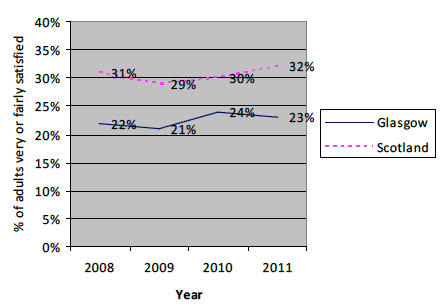
Source: SHS
S4: Perception of Community Safety
Why is this indicator important? S4 measures how safe adults feel in their local area after dark. The question 'how safe do you feel walking alone in your local area after dark' is commonly used to measure public anxiety about crime. This will help us to understand the impact of the changes of the physical and social environment in Glasgow; Scottish data is provided for context. Evidence suggests that people will access their local community more if they feel safe within it, through the physical regeneration of Glasgow and the East End and the range of developments being undertaken it is hoped that greater access will be facilitated. Therefore we might expect, as the regeneration is completed, that more people feel safe or very safe within their local area after dark.
Perception of community safety
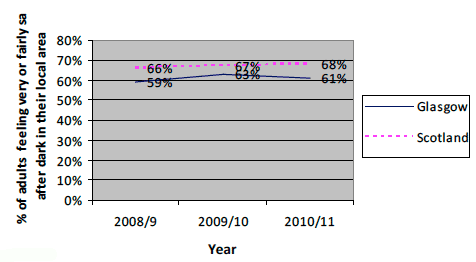
Source: SCJS
What do the data tell us? In 2010/11 the majority of adults in Glasgow (61%) stated that they felt safe (very safe 20%; fairly safe 41%) in their local area after dark, this figure has been broadly consistent since 2008/9. Scottish level data have also been stable with between 66-68% of adults perceiving their area to be safe, with a gender split at a Scottish level showing that males were more likely than females to feel safe (in 2010/11 males feeling very or fairly safe 82% against 55% of females). We will be able to measure this at east end level in 2013 through Go-Well; where participants are asked 'How safe would or do you feel walking alone in this neighbourhood after dark?'
S5. Perception of Crime Rate
Why is this indicator important? The Scottish Crime and Justice Survey asks adults who have lived in their local area for two years or more what their perception is of the crime rate is over the past two years; uncovering whether they believe it has stayed the same, is less or more. It is hoped that the changes to the physical and social environment of Glasgow may impact on this indicator; namely we would expect that there would be an increase in those perceiving crime to have stayed the same or reduced.
What do the data tell us? In table S1, at a Glasgow Community Justice area level, we can see that since 2008 we have seen a small reduction in percentage of people perceiving crime to have stayed the same or reduce.
Table S1: Perception of Crime Rate - % of adults who perceive the crime rate to have reduced or stayed the same
| 2008/9 | 2009/10 | 2010/11 | |
|---|---|---|---|
| Glasgow | 71% | 69% | 69% |
| Scotland | 69.0% | 70.90% | 73.5% |
Source: SCJS
Over the same time period at a Scotland level we have seen the converse with a small increase in those perceiving crime to have stayed the same or reduced. From the Go-Well study we will have East End level data in 2013 for this indicator - Go-Well asks the following question; 'How much would you say the crime rate in your local area has changed since two years ago? Would you say there is more, less or about the same amount of crime?'
S6: International Rating of Personal Safety
Why is this indicator important? The Mercer personal safety ranking is based on measures of internal stability, crime levels, law enforcement effectiveness and host country international relations. Through monitoring this ranking overtime we will be able to consider the impact of the various parts of regeneration as a whole on the variety of measures included. The ranking is utilised by business, most commonly, to assess the risk of personnel working in cities around the world. Glasgow is compared with other relevant cities, which may change over time. As noted above, currently within Scotland we have the lowest actual crime rate since the 1970's and if this stays at similar levels we might expect that Glasgow could move up the rankings over time.
What do the data tell us? In 2011 Glasgow was 44th in the Mercer Personal Safety World ranking for personal safety (In 2008, the last time this was reported Glasgow was ranked 43rd). In 2011 it shared it's ranking with Aberdeen (also ranked 44th) and together they are the highest ranked UK cities. Melbourne, a former Commonwealth Games host city, is ranked 25th.
S7: Green Space
Why is this indicator important? As described above, an integral part of the Sustainable legacy is creating more community parks and woodland. In order to understand the wider impact of these initiatives it is helpful to measure the area of green space (including parks, woodland, and other open free green spaces) within Glasgow.
What do the data tell us?
Map S1 - Greenspace in the East End of Glasgow
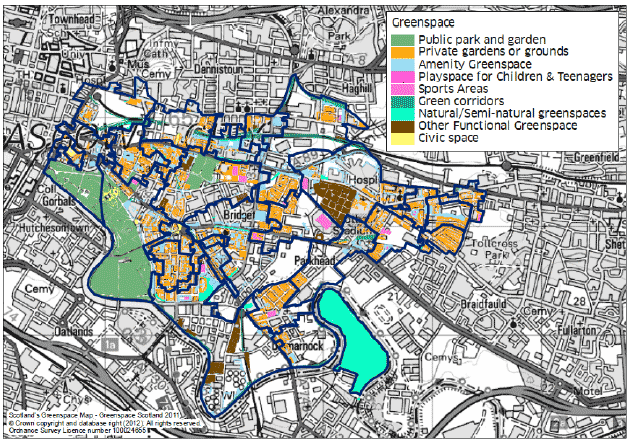
In map S1 we see the greenspace that currently exists within the East End at 2011, this is categorised by type of space. The total area of greenspace in the East End is 203 hectares; with the largest areas being private gardens or grounds (including schools) 56 hectares, public parks and gardens 48 hectares and the Cuningar Loop community woodland 26 hectares.
S8: Vacant and Derelict Land
Vacant and derelict land can affect local community well-being and impacts on the local environment. Vacant land is land which is unused for the purposes for which it is held and is viewed as an appropriate site for development and derelict land (and buildings) is land which has been so damaged by development, that it is incapable of development for beneficial use without rehabilitation. The following indicator examine vacant and derelict land at Glasgow and East End levels.
Land brought back into use (ha)
Why is this indicator important? To help understand more fully the wider impacts of regeneration on Glasgow through the Glasgow 2014 Games it is important to look at the area of vacant and derelict land that has been brought back into use both Glasgow wide and specifically at an East End level.
What do the data tell us?
In table S2 we see that at both a Glasgow and East End level62 a variable amount of land has been brought back into use with a peak at East End level in 2011 and in Glasgow in 2008.
Table S2: Vacant and derelict land brought back into use into use in hectares.
| 2008 | 2009 | 2010 | 2011 | |
|---|---|---|---|---|
| Glasgow | 76 | 56 | 72 | 52 |
| East End | 2.21 | 6.41 | 3.38 | 8.01 |
Source: SVDL
The increase in 2011 would be expected due to the number of Glasgow 2014 Games related projects being taken forward. It is interesting to note that while there has been a reduction in land being brought back into use at a Glasgow level in 2011 we have not seen the same reduction in the East End.
Vacant and Derelict Land
Why is this indicator important? Through examining the area of vacant and derelict land still existing within Glasgow and the East of Glasgow we are able to help establish a fuller picture of the impact of the Glasgow 2014 Games on wider regeneration on the East End and Glasgow more widely.
Total area of derelict land in Glasgow and in the East End of Glasgow
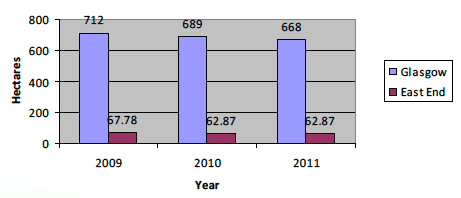
Source: VDLS
What do the data tell us? Following on from S11 we would expect to see that the total area of derelict land within Glasgow and the East End of Glasgow would be reducing. Looking at derelict land alone we see that the reduction has been steady at a Glasgow level from 712 hectares, however at East End level the reduction has not been as pronounced. This may be due to much of the land being utilised for 2014 having already been made ready for use prior to 2009, when our measurement starts.
The total area of derelict and vacant land between 2009-2011 within Glasgow and East End again shows a larger reduction at Glasgow level compared to East End, despite smaller geographies. This may again be due to the land having already transferred to use prior to 2009.
Total area of vacant and derelict land in Glasgow and the East End of Glasgow
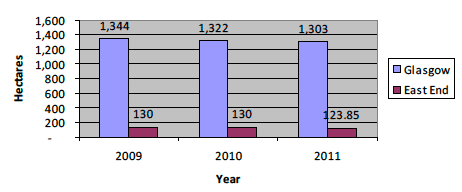
Source: VDLS
S9: Population
Why is this indicator important? As is highlighted above in the review of previous literature regeneration initiatives associated with major sporting events can have both positive and negative impacts. One issue is the relocation of local housing and business, a further issue is the availability of new housing and business premises. A part of measuring the improvement in the physical and social environment of Glasgow and in particularly the East End it is important for us to measure the population over time to understand if there are any population changes in terms of numbers and demographics.
What do the data tell us?
Map S2: Population in the East of Glasgow ranked by Scottish Index of multiple deprivation.
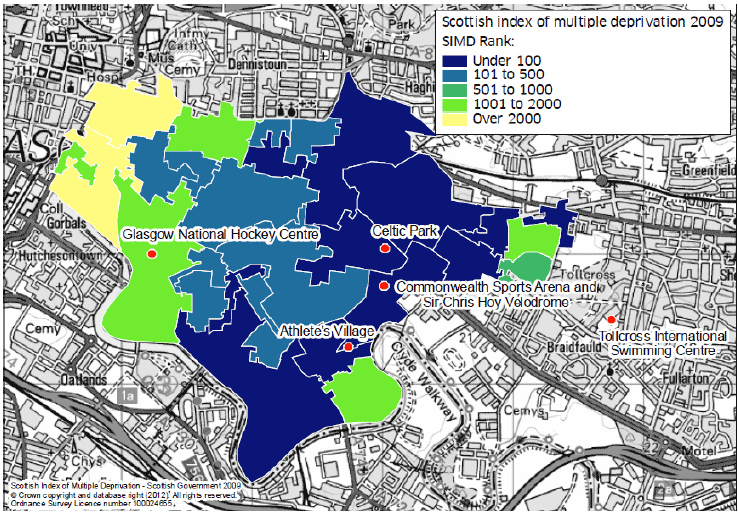
Map 2 uses the Scottish Index of Multiple Deprivation (SIMD) to rank the population in the East End from most to least deprived. SIMD provides a relative measure of deprivation and produces a relative ranking from most deprived (rank 1) to least deprived (rank 6,505).
As you can see within map S2, the population within the East of Glasgow currently falls within the most deprived end of the ranking scale, as can be seen in blue and green. However, we can also see that there are pockets, shown in yellow, within the East End where the population is at the least deprived end of the scale. More detailed examination of the population within the East of Glasgow is being undertaken through the Go Well study (see chapter 2 for more details).
Map S3: Population change in the East End of Glasgow from 2008 -2011
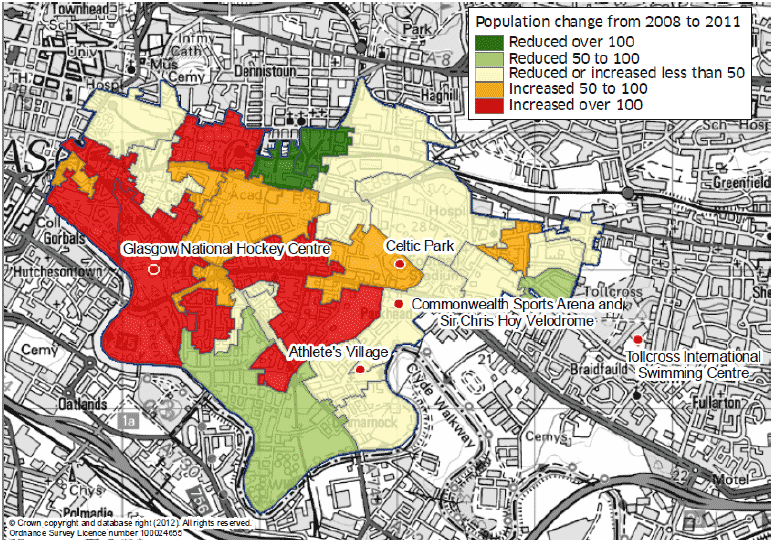
Map S3 shows the population change between 2008-2011, we can see that there has been some variable population change across the area. A large area of the East End population has changed by less than 50 over the time period, however there are also some areas where we see increases in over 100. Over the time period of the evaluation we would expect to see the overall population increase within the East End, particularly once the athletes' village has been readapted.
S10: Quality of Life
Why is this indicator important? This indicator comes from the Mercer Quality of Living Survey, which ranks cities according to 39 different factors based on the following categories: consumer goods; economic environment; housing, medical and health considerations; natural environment; political and social environment; public services and transport; recreation; schools and education; socio-cultural and environment. The survey, which already includes Glasgow, allows us to consider the impact the Glasgow 2014 Games is having on Glasgow's international ranking of quality of living and in turn understand how it has improved the social and physical environment of Glasgow and the East End.
What do the data tell us?
Table S3: Mercer International Quality of living survey for Glasgow
| Year | Ranking |
|---|---|
| 2008 | 56 |
| 2009 | 56 |
| 2010 | 57 |
| 2011 | 56 |
Source: Mercer
In table S3, we can see from the data that between 2008 and 2011 Glasgow has had a very similar ranking, falling slightly in 2010 by one place. Two years prior to hosting the London 2012 Olympics, London were ranked 39th. This compares to former Commonwealth Games hosts Melbourne who were ranked 18th in the same year. European cities dominate the top places in the quality of living survey; with Vienna ranked 1st, followed by Zurich in 2nd place, Munich in 4th and Dusseldorf in 5th, Auckland is the only non-European city and is ranked 3rd. It is expected that as preparations for the Glasgow 2014 Games continue we will see Glasgow move up the ranking.
Conclusion
Overall we can already see that Glasgow has improving perceptions of neighbourhood improvements and that there has been increases in the number of people seeing their community as a very good place to live (between 2008-2010). This is set within the context of the lowest crime rate since the 1970's, however there has been a reduction in the number of those in Glasgow perceiving the crime rate to have stayed the same or reduced. We also reductions the amount of land being vacant or derelict at a Glasgow and East End level, showing the impact of the regeneration and development programmes. There are indications here that the foundations are set for overall improvement of physical and social environment of Glasgow, and in particular the East End.
2) Strengthen and empower communities in Scotland and the Commonwealth.
The impact that the Glasgow 2014 Games will have on people's lives and its ability to help people live more sustainably is being measured within this section. The indicators outlined above also relate to this intermediate outcome, highlighting the interconnected nature of Sustainable legacy.
Due to the range of individual programmes being undertaken and the specific nature of the 'commonwealth' aspect of this intermediate outcome, we have not been able to identify as many indicators that are fit for purpose. Therefore, this outcome will be examined in more detail within qualitative evaluative work, which is currently being developed, and further analysis of monitoring data, that is already being collected by the Scottish Government. The ecological study being undertaken as part of the Go Well study in the East End (see Chapter 2 para 18) will also feed into our understanding of this intermediate outcome. All of this work will be developed over the next 18 months and be referenced in future reports.
The indicator outlined below focuses on capturing how the Glasgow 2014 Games will empower communities, which is being facilitated through programmes such as Sport Relief Home and Away and Games for Scotland.
S12: Perception of community influence
Why is this indicator important? S12 looks at the proportion of adults who feel that they can influence descisions in their local area and the data is from the Scottish Household Survey. This indicator helps us to understand the impact the Glasgow 2014 Games is having on perceptions of community decision making. It is considered at a Glasgow and a Scotland level to help us pick up on the impact of a variety of legacy programmes which seek to empower communities. We anticipate that we will see an increase in the number of adults feeling that are able to influence decisions over the time period; particularly within the East End of Glasgow.
Perception of community influence
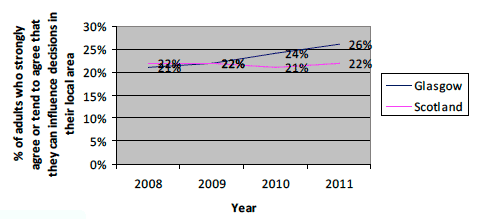
What do the data tell us? Adults believing that they can influence descisions in their local area has been streadily increseasing year on year in Glasgow, since 2008 from 21% to 26% in 2011 either agreeing strongly or tending to agree with the statement "I can influence decisions in my local area". However, at a Scottish level we have seen consistent levels around 22% for the same time period. We will have east end level data through Go Well in 2013, where the respondents will be asked whether they agree with the statement 'I can influence decisions in my local area'.
Conclusion
We can see from the above indicator that there is a higher perception of community influence at a Glasgow level when compared to the rest of Scotland. The other aspects of strengthening and empowering communities will be measured through additional analytical and monitoring work which will be reported in 2013.
3) Demonstrate Sustainable Design and Environmental Responsibility.
Four indicators have been chosen to measure the impact of demonstrating sustainable design and environmental responsibility. The indicators examine issues relating to sustainable building design through the house quality, energy efficiency of new builds and environmental behaviours.
S12: Neighbourhood Cleanliness
Why is this indicator important? Utilising LEAMS (Local Environmental Audit and Management System), which is a statutory Performance Indicator of street cleanliness for local authorities in Scotland, we hope to help examine the overall impact of the Glasgow 2014 Games to demonstrate environmental responsibility. Data is collected at local authority level on an annual basis and we will compare the overall cleanliness rating for Scotland and for other similar cities (those ranked within the urban classification in LEAMS). If we consider the potential demonstration effect of the Games within the environmental responsibility element of 'sustainable' we would expect to be able to see some impact across Scotland over the time period.
What do the data tell us?
Table S4: National percentage distribution of cleanliness grades awarded
| Scotland | ||||
|---|---|---|---|---|
| % Acceptable | %Unacceptable | |||
| Grade A | Grade B | Grade C | Grade D | |
| 2010/11 | 28% | 68% | 4% | 0.2% |
| 2009/10 | 25% | 71% | 4% | 0.2% |
| 2008/9 | 26% | 70% | 4% | 0.2% |
Source: LEAMS
Local Authorities (LAs) are assessed and given a grading on an A-D scale; with A being the highest and D being the lowest. Grades A&B are classed as 'acceptable' and Grade C&D as 'unacceptable'. From the Scottish level data we see that while throughout Scotland most LAs achieve an 'acceptable' grading most of these are at a B grade.
Table S5: Percentage distribution of cleanliness grades awarded in urban areas
| Urban | ||||
|---|---|---|---|---|
| Grade A | Grade B | Grade C | Grade D | |
| 2010/11 | 36% | 61% | 2% | 0.10% |
| 2009/10 | 31% | 67% | 3% | 0.01% |
| 2008/9 | 31% | 66% | 3% | 0.10% |
Source: LEAMS
If we look in detail at those LAs classified as 'urban' within LEAMS (Aberdeen, Dundee, East Dunbartonshire, Edinburgh, Falkirk, Glasgow City, North Lanarkshire, Renfrewshire and West Dunbartonshire). We can again see that the majority are classified as Grade A or B, however we see that since 2008 there has been an increase in LAs being classified as Grade A within the Urban category. We will add Glasgow specific data in future publications.
S13: Rates of recycling
Why is this indicator important? S13 is within the environmental element of sustainable and allows us to look at households recycling habits across the time period. The Scottish Household Survey asks adults whether they have recycled items in the past week. This provides us with data to help us understand how the Glasgow 2014 Games engenders environmental responsibility, we are examining this particularly at a Glasgow and East End level, with Scottish data being provided as context only.
What do the data tell us? Between 2008 and 2011 we have seen small increases in those households reporting that they have recycled items in the past month, from 76-81% at a Glasgow level and 87-89% at a Scottish level. In recent years we have seen historic high levels of recycling among households in Scotland. In 2013, we will have data from on the Go Well study on a very similar variable; whether adults sort household waste for recycling.
Rates of recycling
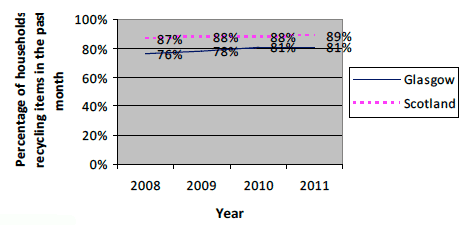
S14: Waste destination
Why is this indicator important? S14 looks at the destination of waste at a Glasgow level and for context a Scottish level, this allows us to monitor whether the destination of waste changes over time. SEPA has published an annual Waste Data Digest (the digest) since 2001. It deals with data collected by, or on behalf of, SEPA on controlled waste in Scotland. The digest covers waste arising, recovery and disposal, and includes data on local authority collected municipal wastes, as well as on commercial and industrial wastes.
The data reported has been obtained from the WasteDataFlow database. This is a web-based system for reporting on municipal waste collected by UK local authorities. All Scottish local authorities have used WasteDataFlow since 1 April 2006 to report data on waste arising, recycling and disposal.
Table S6: Destination of municipal waste
| Glasgow | Landfilled | Incinerated | Recycled | Composted |
|---|---|---|---|---|
| 2008/9 | 80% | 0% | 10% | 10% |
| 2009/10 | 78% | 0% | 11% | 11% |
| 2010/11 | 76% | 0% | 13% | 11% |
| Scotland | Landfilled | Incinerated | Recycled | Composted |
| 2008/9 | 63% | 3% | 22% | 12% |
| 2009/10 | 61% | 3% | 23% | 14% |
| 2010/11 | 59% | 3% | 24% | 14% |
Source: SEPA
What do the data tell us? The destination of waste has seen some gradual changes over the period from 2008-2010; with a gradual reduction over all in the percentage of waste going to landfill (in Glasgow the reduction was from 80% in 2008 to 76% in 2010 and Scotland wide 63% - 59% over the same time period) and conversely, a gradual increase in the percentage of waste being recycled (10-13% in Glasgow and 22-24% Scotland wide). This is a trend that we would expect to see continue over the time period. The levels of waste being incinerated and composted have remained broadly consistent across the time period, notably no waste at Glasgow level has been incinerated compared to a small percentage at Scotland level.
S15: Understanding of environmental responsibility
Why is this indicator important?
To help understand the wider impact of the environmental responsibility being demonstrated by the Games 2014, or promoted through Legacy Programmes specifically, we are conducting omnibus survey work with young people through the MORI schools omnibus. With field work commencing in October young people will be asked what do you think are the two most important things people can do to protect the environment?
Also through the Go Well study we are able to look at adults sustainable attitudes and behaviours; participants are asked whether they avoid overfilling the kettle or choose products with less packaging.
What do the data tell us?
The field work for the MORI schools omnibus is due to commence in October and we would hope to be able to track young people's attitudes towards the environment over time and once we have time series data this will be included as part of the baseline report. We should have data from Go Well in 2013 and this will be included in future reports.
Conclusion
Adults are undertaking recycling on a regular basis and within Scotland and Glasgow there are increasing rates of recycling of municipal waste. The majority of Scotland's council areas are achieving an acceptable LEAMS rating and over time we will also have data on environmental understanding. These indicators come together to help create an understanding of how sustainable design and environmental responsibility are being demonstrated and how this is impacting on attitudes and behaviours.
Overall Conclusion
The 'Sustainable' intermediate outcome indicators above seek to monitor how a legacy will be developed on improving the physical and social environment of Glasgow, in particular the east end; strengthen and empower communities in Scotland and the Commonwealth; demonstrate sustainable design and environmental responsibility. There are already indications that Glasgow, and particularly the East End of Glasgow, are seeing changes in the physical and social environment, including reductions in the area of vacant and derelict land and improving perceptions of neighbourhood improvements in the past three years. We can also see evidence that people feel more able to influence community decisions at a Glasgow level when compared to the rest of Scotland.
Contact
Email: Imelda Giarchi
There is a problem
Thanks for your feedback